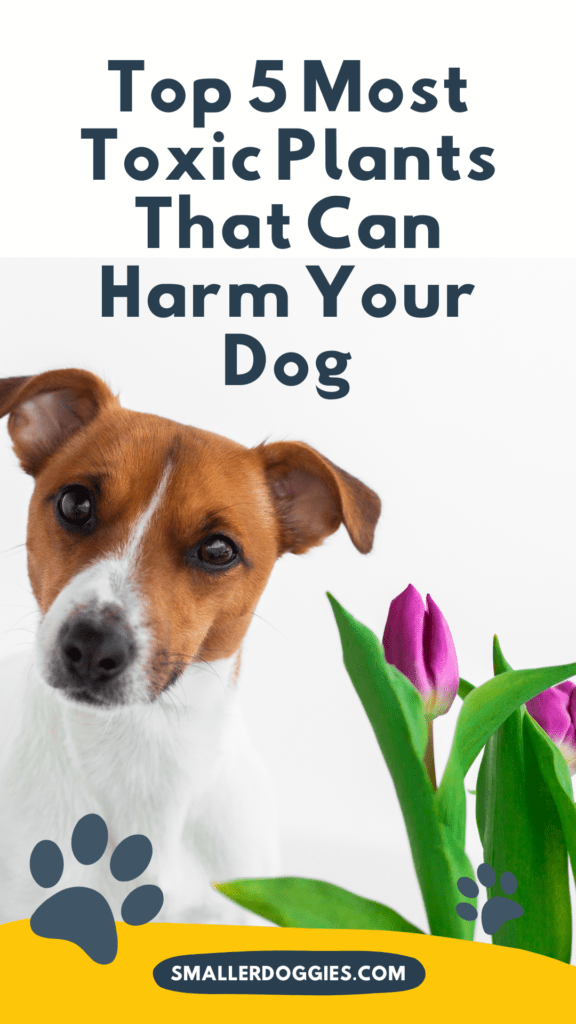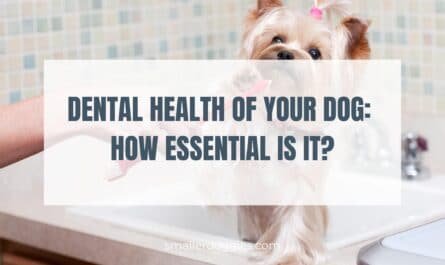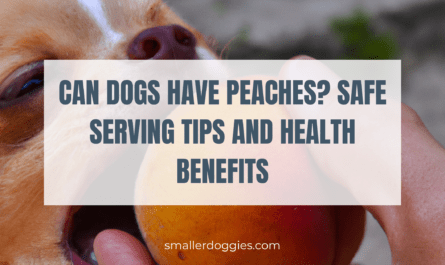Post Disclaimer
This post may contain affiliate links. If you use these links to buy something we earn a commission at no extra cost to you. Smaller Doggies is supported by its audience, Thank you!
As a dog owner, you always want to ensure that your furry friend stays healthy and happy. While you may be aware of common hazards like chocolate and chicken bones, you may not know that several plants in your garden or house can be toxic to your dog. Ingesting these plants can cause vomiting, diarrhea, and even death in some cases.
It’s essential to know which plants are harmful to your dog and take the necessary precautions to keep your pet safe. Some common plants that can be toxic to dogs include lilies, azaleas, oleanders, and tulips. Even some plants that you may consider harmless, such as aloe vera, can cause gastrointestinal issues and skin irritation in dogs. In this article, we will discuss some of the most toxic plants for dogs and the symptoms to look out for if your dog ingests them.

Here are 5 Common Toxic Plants That Can Harm Your Dog
If you have a dog, it’s important to be aware of the common toxic plants that can harm them. Even if you don’t have these plants in your yard, your dog may come across them while on a walk or visiting a friend’s house. Here are some of the most common toxic plants for dogs:
Lilies
Lilies are beautiful flowers, but they are extremely toxic to dogs. All parts of the plant, including the petals, leaves, and stem, can cause kidney failure in dogs if ingested. Symptoms of lily poisoning in dogs include vomiting, lethargy, and loss of appetite. If you suspect your dog has ingested any part of a lily plant, seek veterinary care immediately.
Sago Palms
Sago palms are a popular landscaping plant, but they are highly toxic to dogs. All parts of the plant, including the seeds, can cause liver failure in dogs if ingested. Symptoms of sago palm poisoning in dogs include vomiting, diarrhea, and seizures. If you have a sago palm in your yard, be sure to keep your dog away from it.
Tulips
Tulips are a common spring flower, but they are toxic to dogs if ingested. The bulbs of the tulip plant are the most toxic part and can cause vomiting, diarrhea, and even heart problems in dogs. If you have tulips in your yard, be sure to keep your dog away from them.
Oleander
Oleander is a popular landscaping plant, but it is extremely toxic to dogs. All parts of the plant, including the leaves, flowers, and sap, can cause heart problems and even death in dogs if ingested. The symptoms of oleander poisoning in dogs include vomiting, diarrhea, and seizures. If you have oleander in your yard, be sure to keep your dog away from it.
Azalea
Azaleas are a popular landscaping plant, but they are toxic to dogs if ingested. All parts of the plant, including the leaves, flowers, and nectar, can cause vomiting, diarrhea, and even death in dogs. If you have azaleas in your yard, be sure to keep your dog away from them.
Knowing which plants are toxic to dogs can help you keep your furry friend safe. If you suspect your dog has ingested any of these plants, seek veterinary care immediately.
Symptoms of Plant Poisoning in Dogs
If you suspect your dog has ingested a toxic plant, it’s important to look for symptoms of plant poisoning. The symptoms can vary depending on the type of plant and the amount ingested. Here are some common symptoms to look out for:
Vomiting
Vomiting is a common symptom of plant poisoning in dogs. If your dog vomits once or twice, it may not be a cause for concern. However, if your dog vomits repeatedly or has blood in their vomit, you should seek veterinary care immediately.
Drooling
Excessive drooling is another symptom of plant poisoning in dogs. If your dog is drooling more than usual, and it’s not related to food or excitement, it could be a sign of plant poisoning.
Tremors
Tremors or shaking can be a sign of plant poisoning. If your dog is shaking uncontrollably or has muscle tremors, it’s important to seek veterinary care immediately.
Diarrhea
Diarrhea is another common symptom of plant poisoning in dogs. If your dog has diarrhea that lasts for more than a day or has blood in their stool, you should seek veterinary care immediately.
Seizures
Seizures can be a serious symptom of plant poisoning in dogs. If your dog has a seizure, it’s important to seek veterinary care immediately.
Dysphagia
Dysphagia or difficulty swallowing, can be a sign of plant poisoning. If your dog is drooling excessively and having trouble swallowing, it’s important to seek veterinary care immediately.
Weakness
Weakness or lethargy can be a sign of plant poisoning in dogs. If your dog is unusually tired or weak, it could be a sign of plant poisoning.
Foaming at the mouth
Foaming at the mouth can be a sign of plant poisoning in dogs. If your dog is drooling excessively and has foam around their mouth, it’s important to seek veterinary care immediately.
Remember, if you suspect your dog has ingested a toxic plant, it’s important to seek veterinary care immediately.
Preventive Measures
As a responsible dog owner, it’s important to take preventive measures to protect your furry friend from toxic plants. Here are some effective ways to keep your dog safe:
Safe Gardening Practices
When it comes to gardening, it’s crucial to choose plants that are safe for dogs. Some popular dog-friendly plants include marigolds, sunflowers, and zinnias. Before planting anything new, make sure to research the plant’s toxicity level and keep it out of your dog’s reach.
If you already have toxic plants in your garden, consider removing them or fencing them off. Additionally, keep gardening tools and chemicals out of your dog’s reach to prevent accidental ingestion.
Training Your Dog to Avoid Plants
Training your dog to avoid toxic plants can go a long way in preventing plant poisoning. Start by teaching your dog basic obedience commands such as “leave it” and “drop it.” This will help you redirect your dog’s attention away from plants and other potential hazards.
You can also use positive reinforcement training to reward your dog for avoiding toxic plants. Offer your dog treats and praise when they choose to ignore a plant or move away from it.
In addition to training, it’s important to supervise your dog when they’re outside. Keep an eye on them and redirect their attention if you notice them getting too close to a toxic plant.
By following these preventive measures, you can help keep your dog safe from toxic plants. Remember to always research the toxicity level of plants before bringing them into your home or garden.
Emergency Response to Toxic Ingestion
If you suspect that your dog has ingested a toxic plant, it’s essential to take immediate action to minimize the risk of harm. Here are some steps you can take to respond to a toxic-ingestion emergency:
Immediate First Aid
The first thing you should do is remove any remaining plant material from your dog’s mouth and rinse their mouth with water. If your dog has vomited, collect a sample of the vomit to show to your veterinarian.
Next, assess your dog’s symptoms. If your dog is showing signs of distress, such as vomiting, diarrhea, or difficulty breathing, you should contact your veterinarian or an emergency animal hospital immediately. If your dog is unconscious, not breathing, or has no pulse, you should perform CPR and seek veterinary care immediately.
When to Seek Veterinary Care
If your dog has ingested a toxic plant, you should contact your veterinarian or an emergency animal hospital as soon as possible. Even if your dog is not showing any symptoms, it’s important to seek veterinary care to determine if the plant is toxic and if your dog requires treatment.
Your veterinarian may recommend inducing vomiting to remove any remaining plant material from your dog’s stomach. Alternatively, they may administer activated charcoal to absorb any toxins in your dog’s digestive system. In severe cases, your dog may require hospitalization and supportive care, such as intravenous fluids or oxygen therapy.
Remember, prevention is the best way to protect your dog from toxic plant ingestion. Keep your dog away from plants that are known to be toxic, and supervise your dog when they are outside to prevent them from eating anything they shouldn’t.
Resources for Dog Owners
As a responsible dog owner, it’s important to be aware of the plants that can harm your furry friend. While we’ve provided a comprehensive list of toxic plants, it’s always a good idea to have additional resources at your disposal. Below are some resources that can help you keep your dog safe from toxic plants.
Pet Poison Helplines
If you suspect that your dog has ingested a toxic plant, it’s important to act fast. The following pet poison helplines can provide you with the guidance you need to ensure your dog receives the appropriate treatment.
- ASPCA Animal Poison Control Center This 24/7 helpline can be reached at (888) 426-4435. They charge a consultation fee, but your pet insurance may cover it.
- Pet Poison Helpline: This 24/7 helpline can be reached at (855) 764-7661.
Educational Materials
It’s always a good idea to educate yourself on the plants that are toxic to dogs. The following resources can provide you with the information you need to keep your furry friend safe:
- American Kennel Club: The AKC provides a comprehensive list of plants that are toxic to dogs, along with information on the symptoms of poisoning and what to do if your dog ingests a toxic plant.
- Animal Poison Control Center: The ASPCA’s Animal Poison Control Center provides a list of toxic and non-toxic plants, along with information on the symptoms of poisoning and what to do if your dog ingests a toxic plant.
- Preventive Vet: Preventive Vet provides a list of common household plants that are toxic to dogs, along with information on the symptoms of poisoning and what to do if your dog ingests a toxic plant.
By utilizing these resources, you can ensure that you are well-informed and prepared to keep your dog safe from toxic plants.
Frequently Asked Questions
How long does it take for a dog to show signs of poisoning from a plant?
The time it takes for a dog to show signs of poisoning from a plant varies depending on the type of plant and the amount ingested. Some plants can cause symptoms within minutes, while others may take several hours or even days. Keep in mind that some symptoms may not appear until it is too late to treat the poisoning effectively. It is essential to seek veterinary attention immediately if you suspect your dog has ingested a toxic plant.
What if my dog eats a whole plant?
If your dog eats a whole plant, it is crucial to seek veterinary attention immediately. Eating a large amount of a toxic plant can cause severe symptoms and even death. Do not induce vomiting unless instructed to do so by your veterinarian. Some plants can cause more damage to the esophagus or lungs if they vomit back up.
How should I respond if my dog has consumed a potentially poisonous plant?
If you suspect your dog has consumed a potentially poisonous plant, contact your veterinarian immediately. Try to identify the plant and bring a sample with you to the veterinarian’s office. The veterinarian may induce vomiting, administer activated charcoal, or provide other treatments, depending on the type of plant and the severity of the symptoms.
How can I identify plants in my garden that may be harmful to my dog?
To identify plants in your garden that may be harmful to your dog, consult with a veterinarian or a horticulturist. You can also do research online or use a plant identification app to help you identify plants in your garden. Keep in mind that some plants may not be toxic to dogs in small amounts, but can cause severe symptoms if ingested in large quantities. It is always best to err on the side of caution and keep potentially harmful plants out of your dog’s reach.
After exploring the various methods for identifying potentially harmful plants in your garden, it’s clear that vigilance and precaution are essential when it comes to protecting your furry friend. Consulting with a veterinarian or horticulturist, conducting online research, or utilizing plant identification apps can all aid in identifying toxic plants that can harm your dog. Remember, even plants deemed non-toxic in small amounts can lead to severe symptoms if ingested in large quantities. Therefore, it’s crucial to err on the side of caution and ensure that potentially harmful plants are kept out of your dog’s reach to maintain their safety and well-being.







